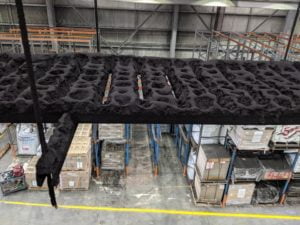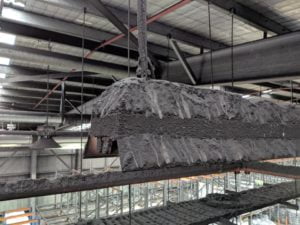Combustible Dusts
Combustible Dusts: All hazardous area equipment for use in combustible dust environments must be installed in accordance with AS/NZS 61241.14 (until September 2011) and with AS/NZS 60079.14
Combustible dusts are not as well understood as a hazard as are, say, flammable gases and vapours.
Ignitions of combustible dusts can cause incredible destruction, usually due to the primary explosion raising the layers of dust, forming huge dust clouds which are ignited by the fires of the first explosion.
Dusts which have caused fires and explosions in the past are:
MDF sandings (from final product sanding/parting saw area particularly)
Foodstuff powders (sugar, flour, coffee, milk powder for example)
Metal filings (aluminium, magnesium)
Fibres (wool, cotton, paper)
Trimmings (plastic from packaging plants)
Industrial (coal, sulphur, carbon dust, shale dust)
Medications (paracetamol for example)
DUSTS AIN’T GASES
For a gas or vapour to ignite, three things are required:
Fuel (in the correct ratio with the oxidizer to react)
Oxidizer
Ignition Source
Combustible dusts also need following:
Dispersion
Confinement
Dispersion of dusts simply ensures maximum contact of all dust particles with oxygen in the air.
Clearly, dust dispersion (or indeed the presence of dust) is to be avoided. Sacrificial panels should also be employed in rooves and walls to ensure pressures do no buildup to a point where the integrity of the structure is compromised.
Confinement of dusts ensures that, if there is an ignition of the dust cloud, large pressures will build up until the structure confining the explosion fails (like the walls and roof of the plant). Clearly, this too is undesirable.
PREVENTION OF EXPLOSIONS
http://www.hse.gov.uk/pubns/wis32.pdf
SECONDARY DUST EXPLOSION MECHANISM
Combustible Dust explosions can have small beginnings.
However, even a small explosion can cause dust layers to become airborne, creating large clouds of combustible dust which may only need an ignition source (probably from the fire cause by the first explosion) to create secondary explosions.
These secondary explosions can result in a cascade effect, causing the destruction of entire factories with multiple injuries and deaths.
Housekeeping
In many plants designed for the handling and processing of flammable materials, dust may escape from equipment and settle on the floor and on fixtures and fittings in the workroom. In the settled state the dust is not explosive but any unusual shock may displace some of it and disperse it in the form of a dust cloud. This shock is often caused by a relatively mild primary explosion inside the plant, the flame from which serves as a means of ignition for the dust cloud formed in the workroom. This secondary explosion disperses more of the dust accumulated in the workroom and ignites these clouds until the whole building is swept by the explosions. Accumulation of dust in workrooms is the cause of major explosions and its elimination is vital.
The following precautions should be observed:
(1)The dust must be prevented from escaping from the plant, which should be designed and constructed with this end in view. All joints should be flanged and packed. All inspection doors, slide valves etc., should be dust tight.
(2)Where practicable, the plant should be operated under a slight negative pressure to reduce the egress of dust.
(3)At charging and bagging-off points complete enclosure of the plant is not always practicable. To prevent dust from entering the workroom these points should be enclosed as far as possible by means of a hood or cabinet. The access openings should be reduced to a minimum. Local exhaust ventilation should be provided to control the dust cloud within the cabinet.
(4)The handling of sacks containing dusty material is a common cause of dust in workrooms. Sack storage should be avoided in rooms in which milling and similar processes are carried out. Such storage should be in a separate warehouse from which all plant in which a primary explosion could occur is excluded.
(5)In spite of all precautions some dust will always escape from the plant. It must be prevented from accumulating in workrooms by the regular and frequent cleaning of all parts of the room and plant on which it may settle. Careful design and construction of workrooms facilitates this cleaning. All horizontal surfaces on which dust can collect should be avoided. Window sills, door frames and projecting fittings should be made flush with the wall. Other horizontal surfaces like girders, beams and ledges should be bevelled to prevent settlement. Walls should be made smooth and corners should be rounded. Vacuum cleaning is recommended for dust removal. In small factories portable vacuum cleaners may be used provided the electrical equipment is safe for use when exposed to flammable dusts. A static vacuum pump fitted to a ring main is more suitable for large factories; the ring main should be provided at intervals with facilities for the connection of flexible cleaning hoses. Soft brooms may be used provided care is taken to avoid the generation of dust clouds.
The use of compressed air for cleaning is not recommended
The right way – methods using a vacuum extraction system with antistatic properties are advised (including portable systems), with water under pressure as a last resort.
The wrong way – blowing the dust down with Compressed Air which simply creates dust clouds, probably worse than any initial explosion ever could. This is a near suicidal method and cannot be discouraged enough.
Strategy – during any maintenance shutdown, de-energise the plant in that area, have if declared SAFE by a hazardous area expert (with insurance) and clean all level surfaces, starting from the structural members in the roof and working down. This is also a good time to have the periodic inspections of the equipment in your hazardous area dossier and update it.
Cyclic housekeeping will minimise problems.
Also have the plant declared SAFE by a hazardous area expert (with insurance) before re-energising the plant
COMBUSTIBLE DUST: AN INSIDIOUS HAZARD
https://www.youtube.com/watch?v=3d37Ca3E4fA
COMBUSTIBLE DUST DEMO


